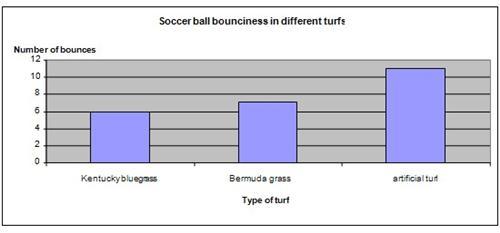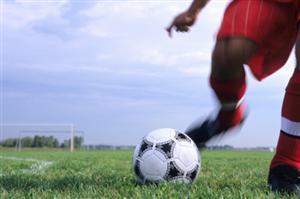| Complexity level: | 4 |
| Project cost ($): | 20 |
| Time required: | 1 hour to prepare, 1 day for science project experiment |
| Material availability: | Easily found. You can borrow a soccer ball from a friend, or purchase one at a sports store |
| Safety concerns: | None |
Hypothesis
A soccer ball will bounce the most number of times on artificial turf.
Overview
Soccer ball physics
Soccer balls must be inflated with air before they can be played with. When air is pumped into the ball, the number of air molecules and consequently, the air pressure inside the ball increases. The ball starts to gradually inflate and expand outwards. Once the air pressure outside and inside the ball is the same, equilibrium is reached. Pumping more air into the ball beyond equilibrium will increase the tension on the latex wall of the ball and make the surface of the ball harder.
Raising the soccer ball to a higher position will increase its potential energy. As a soccer ball drops, the potential energy in the ball is converted into kinetic energy. Once the ball hits the ground, there will be a deformation of the shape of the ball and the kinetic energy will be converted into compressed potential energy. As the air decompresses, this potential energy is converted back into kinetic energy as the ball bounces upwards.
The same thing happens when the soccer ball is kicked. During impact between a player's foot and the soccer ball, the shape of the ball is "deformed" and the air in the ball becomes compressed. This compressed energy is then converted to kinetic energy resulting in a rebound that causes the ball to travel fast and for a great distance.
Scientific Terms
Materials
The materials required for this science fair project:
- A soccer ball
- A measuring tape
- A field of Kentucky bluegrass
- A field of Bermuda grass
- A field of artificial turf
- An assistant
Procedure
1. For this science fair project, the independent variable is the type of turf i.e. Kentucky bluegrass, Bermuda grass and artificial turf. The dependent variable is the bounciness of the soccer ball. This is determined by observing and counting the number of times the ball bounces off the turf. The constants (control variables) are the height from which the ball is dropped, the type of ball and the moisture of the grass on the field.
2. 3 locations of fields of Kentucky bluegrass, Bermuda grass and artificial turf are selected. If necessary, other types of turf can be used. A trip to the 3 fields is made with the assistant (don't forget the soccer ball!).
3. With the help of the assistant and a measuring tape, hold the soccer ball at a height of 2 meters. The ball is dropped from that height. The number of times the ball bounces off the ground is counted. The test is repeated 10 times and the average number of bounces is calculated. Record the results in the table given below.
4. Procedure 3 is repeated for all 3 types of turf and the results recorded in the table below.

Results
The soccer ball bounced the most number of times on the artificial turf compared to the Kentucky bluegrass and Bermuda grass turfs.
| Type of turf | Kentucky bluegrass | Bermuda grass | artificial turf |
| Number of bounces | 6 | 7 | 11 |
Use the graph below to plot the results of the science project experiment:

Conclusion
The hypothesis that a soccer ball will bounce the most number of times on artificial turf is correct.
The type of turf or the condition of the ground does contribute to the bounciness of a soccer ball. The same goes for other types of sports such tennis. When the ball hits the ground, some energy will be lost in the impact between the ground and the ball. The deformation of the shape of the ball will cause friction between the rubber molecules and some energy is lost in the form of heat. The amount of deformation will depend on the hardness of the ground and the type of grass on the turf.
Also consider
This science fair project can also be repeated to test the bounciness of the soccer ball at different air pressure levels.
Try to repeat the experiment on a hot afternoon and once more on a cold night and compare the results.
What if the soccer field is at a higher altitude? Does that make a difference?
References
Physics of soccer -http://lc3.littlechute.k12.wi.us/High%20School/Academics/Science%20Department/Janssen/Physics%20Of%20Project/projects/soccerandrewphil/inflation.html
Bouncing balls home page - http://www.howeverythingworks.org/bouncing_balls.htm

